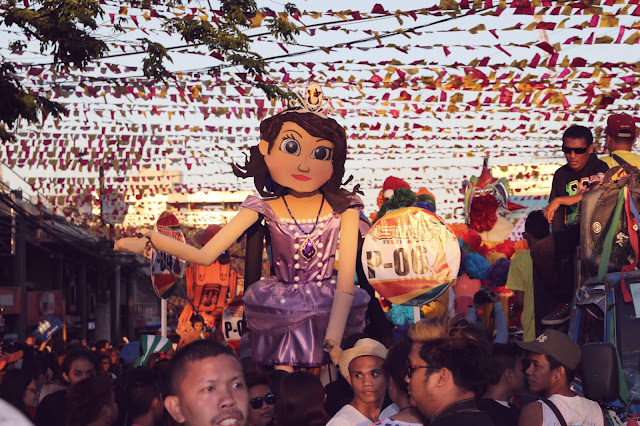History
Referrence: http://cebu.sunstar.com.ph/sinulog/history/
“Pit Senyor kang Mama kini, Pit Senyor kang Papa kini..” is the chant completing devotees’ offering dance of Sinulog in honor of the miraculous Santo Niño.
A pageantry of faith, a festival held in honor of the Santo Nino, celebrating the origin of the island of Cebu–this is Sinulog.
Sinulog is a dance ritual in honor of the miraculous image of the Santo Niño. The dance moves two steps forward and one step backward to the sound of the drums. This movement resembles the current (Sulog) of what was known as Cebu’s Pahina River. Thus, in Cebuano, it’s Sinulog.Historians say that Sinulog is the link between the country’s pagan past and its Christian present.
Historical accounts say before Portuguese navigator came to Cebu on April 7, 1521 to plant the cross on its shore and claim the country for the King of Spain, Sinulog was already danced by the natives in honor of their wooden idols and anitos.
Then Magellan came and introduced Christianity. He gave the Santo Niño (image of the Child Jesus) as baptismal gift to Hara Amihan, wife of Cebu’s Rajah Humabon who was later named Queen Juana. At that time, not only the rulers were baptized but also about 800 of their subjects.
However, shortly after the conversion, Magellan died in an encounter with the reigning ruler of Mactan, Rajah Lapu-lapu, on April 27, 1521.What remained of Magellan’s men were able to return to Spain to report the incidentt. It took 44 years before a new group came and started formal Christianization of the islands. Miguel Lopez de Legaspi arrived in Cebu on April 28, 1565. His ships bombarded the village and in one of the burning huts, one of his soldiers named Juan Camus found inside a wooden box the image of the Santo Niño lying side by side with native idols.
Historians now say that during the 44 years between the coming of Magellan and Legaspi, the natives continued to dance the Sinulog. This time, however, they danced it no longer to worship their native idols but as a sign of reverence to the Santo Niño which is now enshrined at the San Agustin Church (renamed Basilica Minore del Santo Niño).
Through the years since 1521, the dance was a small ritual by a few in front of wooden idols or before the Santo Niño. In fact, at the Santo Niño church where the image is consecrated, only the candle vendors could be seen dancing the Sinulog and making offerings.
During the Santo Niño fiesta, which falls on the third Sunday of January, children dressed in moro-moro costumes also dance the Sinulog. This was really no big event for Cebu City.
In 1980, however, David S. Odilao, Jr., then Regional Director of the Ministry of Sports and Youth Development (MYSD), organized the first ever Sinulog parade. He gathered a group of students, dressed them up, taught them how to dance the Sinulog to the beating of the drums. It was a small parade really which went just around the Basilica, but it caught the imagination of the City of Cebu, which then thought of making the Sinulog a festival that would rival all other festivals being held yearly in the country.
Thus, under the direction of then Cebu City Mayor Florentino S. Solon, the Sinulog organization came into being. The first task of the organizing committee was how to conceptualize the festival and make it a big event.
In 1980, the local government had a grand and lucrative idea. The Sinulog fiesta at the time was an affair of local color. Held at the Basilica del Santo Niño, the feast-featured sinulog dancing performed by various groups to fulfill religious obligations. On the third Sunday of January each year, besides the faithful who joined the Sinulog to fulfill a panaad, the event began to attract an increasing number of tourists.
The Cebu City government thus planned to expand the Santo Nino feast celebration and bring this small, regional event to national prominence. In addition, there was an interest in preserving and promoting sinulog dancing as an example of the ” real and unique” Cebuano culture.
After the first year under the direction of the Ministry of Youth and Sports Development, the Sinulog parade Was turned over to the mayor’s office which promptly exploited the commercial possibilities of the festival. Trade fairs, art exhibits, a film festival, and pop music events were added to the gravy train.
Sinulog ’81 was then organized. Practically all sectors in the Cebuano community got involved. To distinguish the festival from the popular Ati-Atihan Festival in Aklan, the organizers decided to use the parade to depict the history of the Sinulog, which, as had been said, is the dance which links the country’s pagan past and Christian present. Seven floats were created to depict seven different periods of history. Each float were followed by dancers wearing costumes depicting the periods.
They all danced the same beat the Sinulog parade started at 1 P.M. at the Cebu Provincial Capitol and ended about midnight at Fort San Pedro-Plaza Independencia area. And the show continued until the wee hours of the morning.
Referrence: http://cebu.sunstar.com.ph/sinulog/history/
Photos by Dream Pixel Studios (Oscar Benjamin "Osby" Ledesma)


























No comments:
Post a Comment